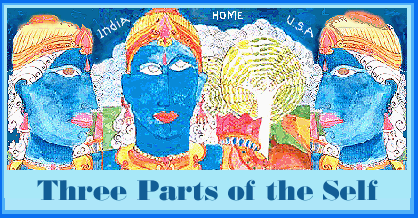Home(s) Abroad: Diasporic Identities
in Third Spaces
Sura P. Rath,
Louisiana State University -- Shreveport
Copyright © 2000 by Sura P. Rath, all rights reserved. This article
is reproduced with the kind permission of the editors of JOUVERT:
Journal of Postcolonial Studies.

- This is the central issue, the core of my argument: the construction
of the Other, the necessity for this Other, and the importance
of the presence of the Other to a continued definition of the
Self. In Margins of Philosophy Jacques Derrida says: "Philosophy
has always insisted upon this: thinking its other. Its other:
that which limits it, and from which it derives its essence, its
definition, its production"(x). I would like to take a somewhat
different route here, though, using as my springboard a model
of the self provided by Jean-Paul Sartre in Being and Nothingness.
Sartre offers a three-part model of the Self: Being-for-Itself,
Being-for-Others, and Being-in-the-World. Later embraced by Maurice
Merlau-Ponty, Georges Gusdorf, and Ernst Cassirer, this model
of the Self helps explain, I believe, the subjective postcolonial
experience and the postcolonial world view in a more inclusive
and less traumatizing way; it also enables the postcolonial, himself/herself
‘othered’ in a hegemonic dominant culture, to engage
the othering forces themselves as Others and to express them as
supplements to the subjective self-consciousness.
- We begin with "the perceiving ‘For-Itself’ which is constituted as
consciousness by distinguishing itself from the world of which it is conscious
and to which it is present" (Kinneavy 398). This ‘For-Itself’ is therefore in
need of the world to establish itself as consciousness; in fact, "to establish
itself as a knowing self-consciousness it must be aware of other knowing
consciousnesses from which it is also distinct, and these other
consciousnesses are the ‘Others.’" As Being-for-Itself, the Self is
constituted by its past, present, and future; it is an image of the self that
has its genesis in history but that encompasses the fluid uncertainty of the
present moment as well as the unrealized potentials that lie far in the
future. Thus it combines both the concrete and the abstract, the known and the
knowable unknown, the genesis and the apocalypse; it is the sum-total of the
‘I’ as seen through my own eye (Sartre 152-72). As Being-for-Others,
the subject Self constructs an image of itself as an object, as it is observed
by everybody beyond the borders of itself. This reverse virtual image lies in
a twilight zone, for the Self’s apprehension of the Other’s perception of
itself is at best partial and incomplete, and more likely mistaken, though the
benign ignorance is likely to follow one to one’s grave. The Being-in-the
World derives from my consciousness of the world as the sum of the
possibilities. These possibilities, Sartre says, are "something which
the For-Itself lacks in order to be itself" (125), instruments of
supplementation. The Self remains splintered in a million consciousnesses as
the bits of potential for-itself.
- In this model of the Self, the consciousness has three components, two of
which -- the second and the third -- are outside the subject self’s
total comprehension; the first, Being-for-Itself, incorporates
the subject self’s action, will, and idea. Yet to satisfy
its hunger for complete self-knowledge, the Self seeks to supplement
its self-image, to fill the absence(s), the missing pieces, by
constructing an ideal Other against which it can articulate its
identity, see its own mirror image, an image confirming the subjective
view already projected into the consciousness. In my earlier work
I have examined the obsession in each culture to discover and
maintain its own tribal past as a means to gauge its progress
from the savage stone age to its present ‘civilized’
status. I have argued that the self’s irrepressible desire/need
to define itself in terms of an Other results in the ubiquitous
images of romanticized and idealized portraits of tribes and tribal
lives in works such as Joseph
Conrad’s Heart of Darkness and James Fenimore
Cooper’s Leatherstocking Tales. In order to fit the
historical processes of transformation to conform to the myth
of our cultural origin and evolution, we sometimes have to modify
or even imagine the exact outlines and features of this Other.
Always polarized between the civilized (here) and the primitive
(there), this inter-dependence is a curious bond that binds the
colonial power and the colonized.
|
|